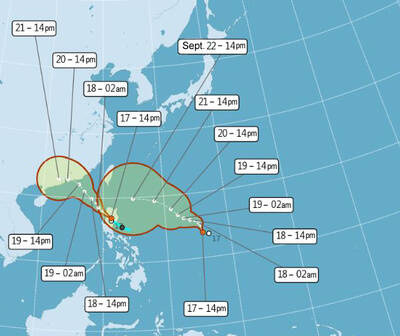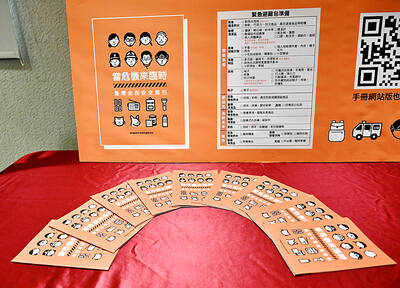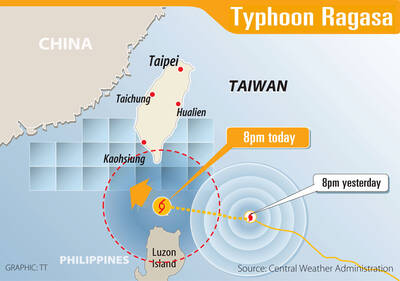The Chinese People’s Liberation Army (PLA) is capable of seizing Taiwanese islands, paralyzing the country’s defensive capabilities with cruise and short-range ballistic missiles, as well as by launching amphibious and airborne raids, to take Taiwan proper before forces from other nations could respond, the Ministry of National Defense said.
In the latest annual report on China’s military forces presented to the legislature, as stipulated in the National Defense Act (國防法), the ministry said that Beijing’s purpose in holding combined air-naval-ground exercises involving the PLA’s Second Artillery Force in recent years was to ensure that it would be able to launch a large-scale attack on Taiwan by next year.
According to the National Bureau of Asian Research, a Washington-based think tank, the Second Artillery Force is a strategic missile force of the PLA tasked with achieving strategic effects through direct engagement of key enemy targets.
China’s military modernization has improved the PLA’s capability to conduct “counterintervention operations” for “regional deterrence” missions to prevent foreign forces, like the US, from intervention in cross-strait conflicts, the report said.
The ministry said that the Second Artillery Force has continued to mass produce and install missiles despite the force already fielding an array of tactical ballistic missiles and cruise missiles that can reach Taiwan.
Meanwhile, the ministry said that the Dong-Feng 21D, medium-range anti-ship ballistic missile has the capability to deny an aircraft carrier from a third country from intervening in a conflict between Taiwan and China.
If a conflict broke out, China would expect to take Taiwan in the shortest time by conducting intensive air, missile and naval strikes, as well as a blockade of the nation with the objective being to cause panic in the country, and conducting an amphibious and airborne operation to land here, the ministry said.
China has previously characterized its military policy as purely “defensive” in nature, but it has shifted the policy to “diversification of armed forces use,” as stated in a Chinese defense white paper this year, the ministry added.
In reaction to the US-Japan island defense exercise in January last year, China held a spate of drills across the East and South China seas to highlight its claims to sovereignty over the region and to declare that the PLA’s primary missions go beyond Taiwan to include the seas, which are both among China’s “core national interests,” the ministry said.
The ministry said that China’s military presence in the South and East China seas — including its declaration of an air defense identification zone in the East China Sea last year — showed that Beijing’s desire to become a dominant power in Asia has endangered regional stability, with sporadic tensions with the US, Japan, South Korea and some Southeast Asian countries.
China’s defense spending has seen double-digit growth each year since 1989, and with a defense budget of US$132 billion this year, China is the biggest military spender in Asia and second only to the US in the world, the defense ministry said.
The ministry added that China views the years up until 2020 as a “strategic opportunity” to enhance its combat capabilities, while the military modernization it has undertaken over the years has turned its military into a force far beyond its need for self-defense.
Despite rapprochement in cross-strait relations, as the military imbalance between Taiwan and China grows and Taiwan remains the PLA’s primary mission, the military threats to the nation from China have not abated, the ministry said.

One of two tropical depressions that formed off Taiwan yesterday morning could turn into a moderate typhoon by the weekend, the Central Weather Administration (CWA) said yesterday. Tropical Depression No. 21 formed at 8am about 1,850km off the southeast coast, CWA forecaster Lee Meng-hsuan (李孟軒) said. The weather system is expected to move northwest as it builds momentum, possibly intensifying this weekend into a typhoon, which would be called Mitag, Lee said. The radius of the storm is expected to reach almost 200km, she said. It is forecast to approach the southeast of Taiwan on Monday next week and pass through the Bashi Channel

The number of Chinese spouses applying for dependent residency as well as long-term residency in Taiwan has decreased, the Mainland Affairs Council said yesterday, adding that the reduction of Chinese spouses staying or living in Taiwan is only one facet reflecting the general decrease in the number of people willing to get married in Taiwan. The number of Chinese spouses applying for dependent residency last year was 7,123, down by 2,931, or 29.15 percent, from the previous year. The same census showed that the number of Chinese spouses applying for long-term residency and receiving approval last year stood at 2,973, down 1,520,

EASING ANXIETY: The new guide includes a section encouraging people to discuss the threat of war with their children and teach them how to recognize disinformation The Ministry of National Defense’s All-Out Defense Mobilization Agency yesterday released its updated civil defense handbook, which defines the types of potential military aggression by an “enemy state” and self-protection tips in such scenarios. The agency has released three editions of the handbook since 2022, covering information from the preparation of go-bags to survival tips during natural disasters and war. Compared with the previous edition, released in 2023, the latest version has a clearer focus on wartime scenarios. It includes a section outlining six types of potential military threats Taiwan could face, including destruction of critical infrastructure and most undersea cables, resulting in

WARNING: People in coastal areas need to beware of heavy swells and strong winds, and those in mountainous areas should brace for heavy rain, the CWA said The Central Weather Administration (CWA) yesterday issued sea and land warnings for Typhoon Ragasa, forecasting that it would continue to intensify and affect the nation the most today and tomorrow. People in Hualien and Taitung counties, and mountainous areas in Yilan and Pingtung counties, should brace for damage caused by extremely heavy rain brought by the typhoon’s outer rim, as it was upgraded to a super typhoon yesterday morning, the CWA said. As of 5:30pm yesterday, the storm’s center was about 630km southeast of Oluanpi (鵝鑾鼻), Taiwan’s southernmost tip, moving northwest at 21kph, and its maximum wind speed had reached